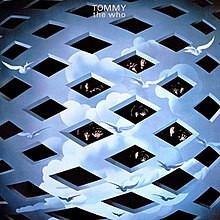Tommy, the fourth studio album by The Who, stands as a monumental achievement in rock history. Released in 1969, this ambitious double album, largely conceived by guitarist Pete Townshend, is celebrated as a groundbreaking rock opera. At the heart of this epic work is the “Overture,” the album’s opening track. This instrumental piece not only sets the stage for the narrative to unfold but also encapsulates the musical and thematic essence of Tommy itself.
The “Overture” from Tommy is more than just an introductory piece; it’s a dynamic and powerful composition that immediately immerses the listener into the world of Tommy Walker, the “deaf, dumb, and blind boy.” It masterfully weaves together key musical motifs and themes that will reappear throughout the album, providing a sonic roadmap of the journey ahead. The energy and complexity of the “Overture” immediately signaled that Tommy was not just another rock album, but a profound and innovative artistic statement.
 Tommy album cover featuring The Who band members, highlighting Pete Townshend, Roger Daltrey, John Entwistle, and Keith Moon, against a white background with bold black lettering of the album title.
Tommy album cover featuring The Who band members, highlighting Pete Townshend, Roger Daltrey, John Entwistle, and Keith Moon, against a white background with bold black lettering of the album title.
The Genesis of Tommy: From Concept to Rock Opera
Pete Townshend’s inspiration for Tommy stemmed from his exploration of the teachings of Meher Baba, an Indian spiritual master. Townshend sought to translate Baba’s principles of compassion and self-realization into a musical narrative. This ambition led to the concept of a “deaf, dumb and blind boy” who experiences the world through vibrations, interpreted as music.
Initially, Townshend experimented with extended musical forms, feeling constrained by the typical three-minute pop song format. Early attempts included “Quads,” an abandoned rock opera project, and “A Quick One, While He’s Away,” a “mini-opera” for the A Quick One album. These experiments paved the way for the more ambitious and fully realized rock opera that Tommy would become.
Tommy’s Narrative: A Synopsis
Tommy tells the story of Tommy Walker, whose life is dramatically altered after witnessing a traumatic event. Following the return of his father, Captain Walker, and a subsequent altercation where his father murders his mother’s lover, Tommy is psychologically traumatized into deafness, dumbness, and blindness.
Despite his sensory deprivation, Tommy develops a rich inner world and an extraordinary sensitivity to vibrations, which allows him to become a pinball wizard. His journey is fraught with challenges, including exploitation and abuse, but also moments of profound realization. Eventually, through a symbolic shattering of a mirror, Tommy regains his senses and becomes a spiritual leader, attracting followers before ultimately facing rejection and returning to introspection.
Key musical pieces within Tommy, beyond the “Overture,” further develop the narrative:
- “It’s a Boy”: Announces Tommy’s birth, setting the stage for his extraordinary life.
- “1921”: Depicts the traumatic incident and Tommy’s induced sensory loss.
- “Amazing Journey/Sparks”: Explores Tommy’s developing inner world and unique perception.
- “Pinball Wizard”: Celebrates Tommy’s unexpected talent and rise to fame.
- “See Me, Feel Me”: Expresses Tommy’s spiritual awakening and connection to the world.
- “We’re Not Gonna Take It”: Represents the disillusionment and rejection Tommy faces from his followers.
Critical Acclaim and Lasting Impact
Upon its release, Tommy was met with widespread critical acclaim, hailed as The Who’s breakthrough album. Critics lauded its ambition, musical innovation, and thematic depth. While its critical standing has slightly shifted over time, Tommy remains recognized as a pivotal and influential album in rock music history.
The album’s success extended beyond record sales. The Who embarked on an extensive tour performing Tommy live, which further cemented their reputation as a dynamic and groundbreaking live act. Performances at Woodstock and the Isle of Wight Festival during this period are legendary.
Tommy’s narrative and music transcended the album format, inspiring numerous adaptations:
- Seattle Opera Production (1971): Brought the rock opera to a classical stage.
- Orchestral Version by Lou Reizner (1972): Reinterpreted Tommy with orchestral arrangements.
- Film Adaptation (1975): Directed by Ken Russell, starring The Who members and other notable actors, visually interpreting Tommy’s story.
- Broadway Musical (1992): “The Who’s Tommy” became a Tony Award-winning Broadway hit, further solidifying Tommy’s place in popular culture.
Tommy’s enduring legacy is evident in its continued relevance and influence on subsequent generations of musicians and artists. The album has sold over 20 million copies and was inducted into the Grammy Hall of Fame, testament to its artistic and commercial success. Reissues and deluxe editions continue to be released, keeping Tommy accessible to new audiences and highlighting its historical significance.
Conclusion: The Enduring Power of Tommy and its Overture
The “Overture” from Tommy serves as a powerful gateway into The Who’s rock opera masterpiece. It encapsulates the album’s energy, thematic complexity, and musical innovation. Tommy itself remains a landmark achievement, demonstrating the potential of rock music to explore complex narratives and profound themes. From its groundbreaking “Overture” to its enduring cultural impact, Tommy continues to captivate and inspire, solidifying its place as a cornerstone of rock history.
